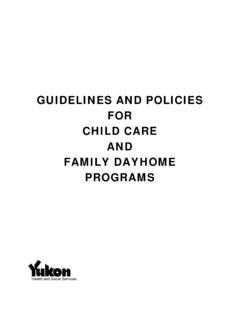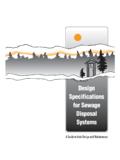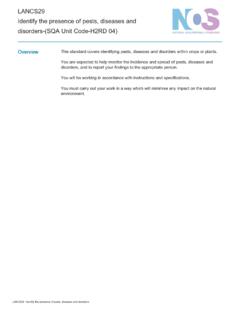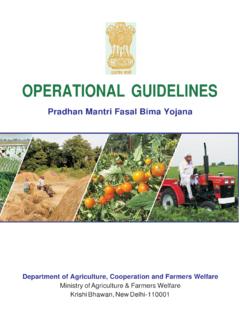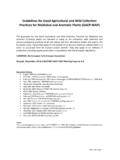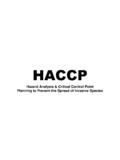Transcription of Food Retail and Food Services Code - Yukon
1 food Retail and food Services code Amended 24 February 2016 Federal/Provincial/Territorial food Safety Committee (FPTFSC) Amended Edition February 2016 Page 2 Preface Canada s food supply is considered one of the safest in the world as the availability of safe, healthy and wholesome food is fundamentally important to Canadians. Our status as a leader in producing safe, quality food is secure as long as we collectively commit to applying sound principles of food safety and education based on scientific knowledge of foodborne illnesses. The study of emerging diseases related to food and our understanding of the role that food can play in the transmission of disease have had a dramatic effect in helping us identify key requirements in food safety and in highlighting the need for various regulatory interventions.
2 Furthermore, global free trade, new food processing technologies and ethnic cultures bring new dimensions to the safety of our food supply. It is estimated that approximately 4 million Canadians acquire foodborne illness each year. Foodborne illness can affect us all but it can be very serious and even life-threatening to some consumers, especially pre-school children, older adults, pregnant women and their unborn child and those with impaired immune systems. Effective control of foodborne illness is vital to avoid adverse effects on human health and to relieve the pressure on an already challenged health system. Prior to 2007, the Canadian food Inspection System Implementation Group (CFISIG) was a collaborative initiative of all levels of government. Its aim was the development of an integrated Canadian food inspection system which is responsive to both consumers and industry.
3 The challenge for all jurisdictions was to continually reduce the risks and achieve excellence in food safety, while supporting the ability of the food industry to adapt to new technology and survive in a competitive environment. Since the last amendment of the food Retail and food Services code in 2004, the CFISIG was regrouped three years later under the Federal/Provincial/Territorial food Safety Committee (FPTFSC) in order to maximize efficiencies. Priorities were set, sub working groups were created and following the updating of the National Guidelines for food Safety Training Programs in the food Retail and food Service Sector, the FPTFSC is now pleased to present the update of the food Retail and food Services code 2016. Contact Point The contact point for the food Retail and food Services code : FPTFSC Secretariat Health Canada Health Products and food Branch food Directorate E- mail: Amended Edition February 2016 Page 3 Table of Contents Purpose and Definitions.
4 6 Roles and Responsibilities for food Safety in Canada .. 6 Purpose .. 6 Application .. 7 Scope .. 7 Guiding Principles .. 7 Outcomes .. 8 Definitions .. 8 Construction, Design and Facilities .. 14 Site and Location .. 14 General Premises Design and Construction Specifications .. 14 Premises Design and Layout .. 14 Construction Plans and Specifications .. 14 Exterior Openings .. 15 Walls and Ceilings .. 15 Floors .. 15 Floors .. 15 Floor Coverings .. 16 Floor Coverings for Temporary food Services .. 16 Floor Drains .. 16 Stairs, Catwalks and 17 Lighting .. 17 Ventilation .. 18 Storage Areas .. 19 Water and Steam Supply .. 20 Sewage and Refuse Disposal .. 21 Plumbing System .. 22 Overhead Utility Lines .. 22 Hand Wash Stations .. 23 Toilet Facilities and Dressing Areas.
5 23 Janitorial Facilities .. 24 Private Homes, Living or Sleeping Quarters .. 25 Temporary food Premises and Mobile food Premises .. 25 Temporary food Services and Farmers Markets .. 25 Mobile food Premises .. 27 food Trucks Without Preparation On-site .. 28 Vending Machines .. 28 Liquid Foods and Ice .. 28 Self-Service Beverages .. 29 Low Risk Foods .. 29 Potentially Hazardous Foods .. 30 Can Openers/ Stirring Mechanisms .. 30 Control of food Hazards .. 31 Control Measures .. 31 Supervision .. 31 food Safety Management Systems .. 31 Control Principles .. 32 Record Keeping .. 33 Amended Edition February 2016 Page 4 Incoming Material .. 33 Approved Sources .. 33 Receiving .. 34 Package Identification .. 34 Disposition .. 35 Temperature Control .. 35 Frozen Foods.
6 35 Thawing .. 35 Refrigerated Storage .. 37 Cooking Raw Foods of Animal Origin .. 37 Hot Holding .. 37 Cooling after Cooking .. 37 Cooling from Room Temperature .. 38 Room Temperature Holding .. 38 Reheating Potentially Hazardous Foods for Hot Holding .. 39 Reheating Potentially Hazardous food for Immediate Service .. 40 Use of Microwave for Cooking or Reheating .. 40 Freezing for Parasite Destruction .. 41 Water .. 41 Water in Contact with food and food Contact Surfaces .. 41 Steam .. 41 Ice as an Ingredient .. 42 Preventing Contamination .. 42 Microbial Contamination .. 42 Physical and Chemical Contamination .. 43 Allergens .. 43 Packaging .. 44 Protection of food Content .. 44 food Grade Packaging .. 44 food Containers .. 44 Reusable Packaging.
7 45 Storage of Packaging Supplies .. 45 Returnable Packaging .. 45 Transportation, Storage and Distribution of food Products .. 46 46 food Transportation, Storage and Distribution Units .. 46 Handling and Transfer of Foods .. 47 Storage Procedures .. 47 Temperature Controls .. 48 Maintenance and 49 Equipment .. 49 Location .. 49 Fixed Equipment .. 50 Design and Construction .. 50 food Contact Surfaces .. 50 Use of Wooden food Contact Surfaces .. 51 Non- food Contact Surfaces .. 51 Cleaned-in-Place Equipment (CIP) .. 51 Filters and Grease Extraction Equipment .. 52 Maintenance .. 52 Maintenance of Cutting Surfaces .. 52 Amended Edition February 2016 Page 5 Heating and Cooling Equipment .. 53 food Temperature Monitoring Equipment .. 53 Containers for Refuse, By-products, Recyclables and Inedible Substances.
8 54 Cleaning and 54 Written Sanitation Program .. 54 Cleaning Frequency: Non- food Contact Surfaces .. 55 Cleaning Frequency: food Contact Surfaces .. 55 Cleaning of food Contact Surfaces .. 55 Sanitizing of food Contact Surfaces .. 56 Mechanical Dishwashing: Chemical Sanitizing Methods .. 57 Mechanical Dishwashing: Hot Water Sanitizing Methods .. 58 Manual Dishwashing .. 58 Pest Management .. 60 Pest Management Requirements .. 61 Controlling Pests .. 61 Immediate Corrective Action .. 61 Eradication of Pests: Methods .. 61 Documentation .. 63 Use of Chemicals and Toxic Substances .. 63 Waste Management .. 64 Waste, Refuse and Recyclable Materials .. 64 Sewage and Other Liquid Waste .. 64 General Maintenance Schedules .. 64 Hygiene and Communicable Diseases.
9 65 Hand washing .. 65 Fingernails .. 66 Clothing .. 66 Hair .. 66 Personal Habits .. 66 Personal Effects and Jewelry .. 67 Illness and Disease .. 67 Injuries .. 68 Visitors .. 68 Educational Programs .. 70 Mandatory Educational Programs .. 70 Training Programs .. 70 Responsibility .. 70 Ongoing Educational Training .. 71 Time Expiration of Training Programs .. 71 Components of food Safety Training Courses .. 71 Certification Programs .. 71 Course Content .. 71 Learning Outcomes .. 72 food Handlers .. 72 Operators .. 72 APPENDIX A: Potentially Hazardous Foods .. i APPENDIX B: Time/Temperature Control - Raw Animal Foods .. v APPENDIX C: Typical food Allergies .. viii Prevention Notes for Consumers and Restaurant ix APPENDIX D: Recall Manuals .. xi APPENDIX E: Selected Information Sources.
10 Xii Amended Edition February 2016 Page 6 Purpose and Definitions Roles and Responsibilities for food Safety in Canada The federal Department of Health (Health Canada) sets standards and policies governing the safety and nutritional quality of all food sold in Canada, throughout the food continuum. The Canadian food Inspection Agency (CFIA) is responsible for enforcing the federal safety and nutritional quality standards established by Health Canada at the food manufacturer and food importer levels across Canada. Provinces and territories (P/Ts) enact legislation governing foods produced and sold within their own jurisdictions. These laws are complementary to federal statutes. The inspection programs of the P/Ts apply to areas including food processing and food service establishments, food Retail , hospitals, nursing homes, community kitchens and food banks within each province.
